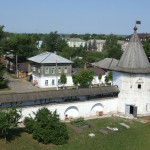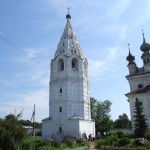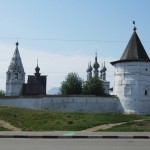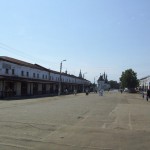Yuriev-Polskiy
Yuriev-Polskiy — is a city in Russia, the administrative center of Yuriev-Polskiy district of Vladimir Region (Oblast). As of 2010, there were 19 595 residents in Yuriev-Polskiy.
The city is situated on the Koloksha River (a confluent of the Klyazma River), 68 kilometers north-west of Vladimir and 180 kilometers north-east of Moscow.
In the chronicles the city was originally called Gyurgev or Gergev – according to the name of its founder, George (Yuri) Dolgorukiy. The second part of the name is derived from the word field (pole); the city is spread on the Suzdal high planes (Opolye in Russian); and it was used to clarify its location, because there were two other cities at that period of time: before 1224 – Yuriev (or Tartu), and after 1224 – Yuriev-Povolskiy (Yurievets), Yuriev on the lower Dnepr, situated in the south patrimony of Suzdal Princes (now this city bears the name Belaya Tserkov).
The parallels between the names Yuriev-Polskoi and Yuriev-Polskiy is noted, in particular, in the Great Soviet Encyclopedia, where these two variants of spelling are cited. At the present moment, on all maps and in all official documents this city is named Yuriev-Polskiy.
The city of Yuriev-Polskiy (Yuriev-Polskoy) was founded on the Koloksha River and its confluent, the Gza River in 1152 by Prince Yuri Dolgorukiy and received its name in honor of the Prince and his heavenly patron – St. George (Yegoriy, Yuri). To distinguish the new city from the old city on the Dnepr, it received the additional name Polskoy, which means, one standing in open fields – in Opolye. The city was surrounded by earthen embankments with a log fence on top. Also at that time, the whitestone church of George was laid in the center of the Prince’s city-fortress.
In the XII-XIII centuries, the role of Yuriev-Polskiy was insignificant. Not far from the city in 1177, a battle took place between the Vladimir and Rostov citizens, which ended in a victory for Vladimir’s Prince Vsevolod III Yurievich (The Big Nest). The second major battle – the Battle of Lipitsk, took place in 1216; this time the victory was won by the Rostov army. In 1212, Yuriev became the center of a small appanage princedom under the rule of Vsevolod III’s son, Sviatoslav. In his time, the new Georgievsky (of George) Cathedral was laid on the old foundation (this one survived till our days in a rebuilt form) and the Mikhailo-Archangelski Monastery (of Archangel Michael) was founded.
Mongol-Tatar Yoke did not pass over Yuriev: in 1238, 1382 and 1408 it was sacked by the Horde’s people. During the rising up of the Moscow Princedom, this small town ended up under the patronage of Moscow and was many times given “for sustenance” to the Prince’s vassals. It is known that in the XV century it was a patrimony of Lithuanian prince Svidrigailo, and in the XVI century – of the Kazan Khan Abdul-Letiff, and after him – of Astrakhan prince Kaibula.
Yuriev accepted Moscow’s rule peacefully. But when Polish-Lithuanian troops took the city in 1609 during the Great Turmoil, and False Dmitry II intended to give it also “for sustenance” to Kasimov prince Magomed Murat, Yuriev people headed by Fedor Krasny rose in rebellion.
After being ruined by the Poles and Lithuanians, Yuriev-Polskiy lived a life of a quiet provincial town. Since 1708, it was included into Moscow Governorate. City status was officially granted to it only under Catherine the Great, in 1778; then it became a district center in the Vladimir vicegerency. In this provincial town in the middle of Opolye life was slow, but it left many traces in its streets and alleys.
Trade was done in this district center – commercial traffic passed through it to Suzdal on the Big Stromynskaya Road. Military men were quartered here; the city had its own merchants and petty manufacturers; the production of fabrics and yarn developed. Through the efforts of the 1st Artillery Grenadier Brigade, which was quartered here, near the east section of the embankments a city park was laid, but almost nothing has remained of it, except for a little garden with a pond and a new monument to Yuri Dolgorukiy.
The war of 1812 did not leave the citizens of Yuriev untouched – the local volunteer corps was under the command of Duke B. A. Golitsyn, who owned the village of Sima, where Bagration later sustained his lethal wound, of which he died.
In 1871, the city sustained a heavy blow – a great fire destroyed many buildings in the central part of the city, both residential houses and all trading facilities, as well as the Vvedensky Monastery. After the fire, the commercial arcade was rebuilt in stone, and in 1893, the Volunteer Firefighters Society was founded in the city with the fire safety station, where amateur plays and dances were staged.
In the beginning of the XX century, Yuriev-Polskiy had up to 6 thousand citizens; 13 textile factories operated here. Lady’s progymnasium, non-classical secondary school and upper elementary school were opened. In 1904, charity hospital opened its doors. In 1913, electricity was installed in the city, and 80 street lights were planned to be put. In the city park during the promenade of the townspeople, concerts of the firefighters’ brass band were given. In 1906, local aristocracy organized the Society of Lovers of the Scenic Art. Political events in the country passed over the city, and almost did not touch it; only a few revolutionary actions took place in the city during this time.
Not much is known about the Soviet period in the life of Yuriev-Polskiy; actually, little has changed in the lives of common people. Monasteries and churches were closed, Lenin’s monument was put in the city park (later it was moved to another place), collective and socialistic farms were formed around the city, factories were nationalized by the government and local administration changed. As for the rest, Yuriev has kept its looks of a backwater district town with trading arcades, merchants’ and townspeople homes and, what is important, unique monuments of the ancient times.
In 1920, the museum of Yuriev’s local lore was founded; later it was transformed into the museum of history of architecture and of arts. From 1974 to 1989, the museum was affiliated with the Vladimir-Suzdal memorial museum. Since 1989, it obtained the status of an independent museum.
Nowadays, Yuriev-Polskiy attracts more and more tourists by its old appearance, tranquility and combination of the nature’s beauty with the modest beauty of an ancient small town with its unique monuments. The earthen embankments of the ancient city are still there, only there is no tall, solid fence on them; the massive gates do not guard the entrance into the Kremlin; and on the once strong defensive fortifications one can walk now in an unhindered way and admire the magnificent cathedral and the views of the monastery and of the entire city.
Material is taken from web resources: http://www.juriev.ru and WIKIPEDIA




